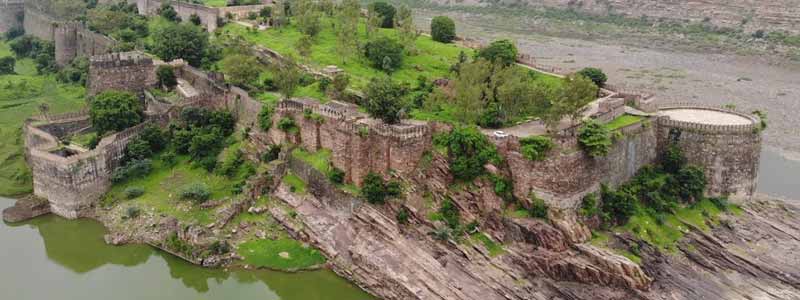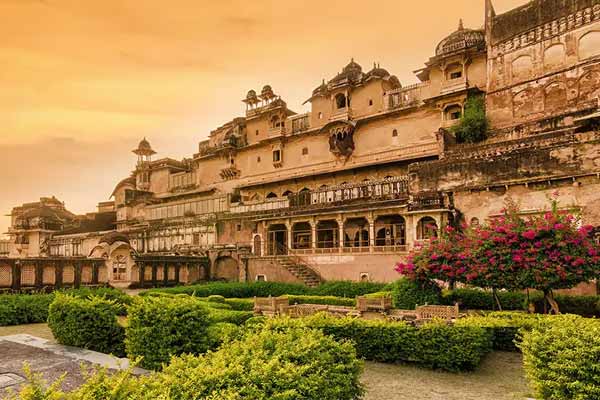Places to Visit in Jhalwar, a historic city in Rajasthan, offers a unique blend of heritage, culture, and natural beauty. Known for its impressive architecture and historical significance, Jhalawar is a must-visit for history enthusiasts. The city is home to the stunning Jhalawar Fort, built by the Jhala Rajputs, which features intricate carvings and grand halls. The ornate Badal Mahal, or “Palace of Clouds,” provides panoramic views of the surrounding landscape.
The city’s rich cultural heritage is further showcased at the ancient Bhawani Natya Shala, a traditional theater renowned for its classical performances. Jhalawar also boasts beautiful gardens and serene lakes, including the picturesque Chandrabhaga Lake, ideal for relaxing and enjoying nature.
For those interested in wildlife, the nearby Kewda and Sunset Point areas offer opportunities for nature walks and bird-watching. Jhalawar’s vibrant bazaars and local cuisine add to the charm, providing a genuine taste of Rajasthan’s hospitality and tradition. Whether exploring historical sites or enjoying nature, Jhalawar promises an enriching travel experience.

Gagron Fort:
Gagron Fort, a UNESCO World Heritage Site, is a stunning example of medieval military architecture located near Jhalawar in Rajasthan. Built in the 12th century by the Chandela rulers, this impressive fort is strategically positioned on a hill, surrounded by the waters of the Ahu and Kalisil rivers, which provide natural defenses and enhance its scenic beauty.
The fort’s architecture features a blend of Rajput and Islamic styles, with massive walls, imposing gateways, and intricate carvings. Its layout includes various structures such as temples, palaces, and granaries, showcasing the fort’s historical significance and grandeur. The fort’s interior is adorned with exquisite frescoes and delicate stonework that reflect the artistic skills of its creators.
Gagron Fort’s historical importance is highlighted by its role in various battles and its strategic location on the trade routes of ancient India. Today, it stands as a testament to the region’s rich heritage and offers visitors breathtaking views of the surrounding landscapes, making it a must-visit destination for history and architecture enthusiasts Places to Visit in Jhalwar.
Jhalawar Fort (Garh Palace):
Jhalawar Fort, also known as Garh Palace, is a majestic structure that epitomizes the grandeur of Rajasthan’s architectural heritage. Built in the 19th century by the Jhala Rajputs, this imposing fort sits atop a hill, offering sweeping views of the surrounding landscape. The fort’s design features a blend of Rajput and Mughal architectural styles, characterized by its intricate carvings, expansive courtyards, and decorative arches Places to Visit in Jhalwar.
The main entrance of the fort is adorned with beautifully painted murals and ornate gateways, leading into a series of lavish courtyards and chambers. The fort complex includes several notable structures such as the Badal Mahal (Palace of Clouds), which was used for royal retreats, and the stunning Zenana Mahal, which showcases the elegance of Rajput royalty with its delicate frescoes and jharokhas (overhanging enclosed balcony).
Visitors to Jhalawar Fort can explore its rich history and marvel at the craftsmanship that defines this historic landmark. The fort remains a testament to the opulence and cultural heritage of the Jhala dynasty.
Bhawani Natyashala:
Bhawani Natyashala, located in Jhalawar, Rajasthan, is a historical theater renowned for its architectural and cultural significance. Built in the 19th century by the Maharaja of Jhalawar, this theater reflects the grandeur of traditional Indian performance arts. The Natyashala is noted for its exquisite design, featuring intricate carvings and an ornate façade that showcases the craftsmanship of the era.
The theater was designed to host classical performances, particularly traditional Rajasthani folk dramas and dance forms. Its acoustics and stage design were meticulously crafted to enhance the theatrical experience, making it a prominent venue for cultural gatherings.
Today, Bhawani Natyashala continues to be a symbol of Jhalawar’s rich cultural heritage. It hosts various performances and cultural events, preserving and promoting traditional arts. Visitors can explore the theater’s historical ambiance and appreciate its role in the region’s artistic legacy. For anyone interested in Rajasthan’s performing arts and architectural heritage, Bhawani Natyashala offers a fascinating glimpse into the past, Places to Visit in Jhalwar.
Chandrabhaga Temples:
The Chandrabhaga Temples in Jhalawar are a remarkable ensemble of ancient Hindu temples situated near Chandrabhaga Lake. Dating back to the 7th and 8th centuries, these temples are renowned for their intricate carvings and architectural splendor. Built during the reign of the Gurjara-Pratihara dynasty, they showcase a blend of classic Hindu temple design and artistic craftsmanship.
The temples are dedicated to various deities, including Shiva and Vishnu, and feature detailed sculptures depicting mythological scenes and deities. The craftsmanship of the temples, with their elaborate carvings and exquisite stonework, reflects the high artistic standards of that era.
The serene setting by the lake adds to the temples’ allure, offering visitors a peaceful atmosphere to explore the historical and religious significance of the site. The Chandrabhaga Temples are not only a testament to the region’s rich cultural heritage but also an important pilgrimage site for devotees. Their historical and architectural value makes them a must-visit for anyone interested in Rajasthan’s ancient temple architecture Places to Visit in Jhalwar.
Government Museum:
The Government Museum in Jhalawar, Rajasthan, is a fascinating repository of the region’s rich cultural and historical heritage. Located in the heart of the city, the museum is housed in a majestic building that reflects the architectural grandeur of the bygone era. Established in 1915, the museum’s collection spans various periods, showcasing a diverse array of artifacts that highlight the artistic and historical significance of the region, Places to Visit in Jhalwar.
Visitors can explore exhibits that include ancient sculptures, intricate carvings, and coins dating back to different dynasties. The museum’s gallery also features an impressive collection of weaponry, textiles, and manuscripts, offering insights into the local craftsmanship and daily life of historical times. Additionally, the museum houses a collection of fossils and geological specimens that reveal the natural history of the area.
With its well-preserved artifacts and informative displays, the Government Museum in Jhalawar provides an enriching experience for history buffs and cultural enthusiasts, making it a valuable destination for understanding the heritage of Rajasthan.
Sun Temple (Jhalrapatan):
The Sun Temple in Jhalrapatan, near Jhalawar, Rajasthan, is a remarkable architectural gem dedicated to the Sun God, Surya. Dating back to the 10th century, this temple exemplifies the grandeur of early Rajput architecture. Its design, influenced by the Solanki style, features intricate carvings and detailed sculptures that reflect the artistic mastery of its era.
The temple’s facade is adorned with elaborate stonework, including depictions of celestial figures and divine scenes. Inside, the sanctum houses a striking image of Surya, depicted riding his chariot drawn by seven horses. The temple’s grandeur is enhanced by its well-preserved sanctum, mandapa (pillared hall), and decorative pillars.
Set against a backdrop of lush landscapes, the Sun Temple is not only a place of worship but also a testament to Rajasthan’s rich cultural heritage. Visitors can admire the temple’s historical significance and architectural splendor while enjoying the serene environment surrounding this ancient marvel. The Sun Temple remains a testament to the region’s artistic and spiritual legacy, Places to Visit in Jhalwar.
Rewa Kund:
Rewa Kund, located in Jhalawar, Rajasthan, is a serene and historically significant site. This ancient water reservoir, built by the Maharaja of Jhalawar in the 19th century, was designed to serve as a crucial water source for the region. The beautifully constructed kund, with its step wells and elaborate stonework, reflects the architectural prowess of the era.
Surrounded by lush greenery and peaceful landscapes, Rewa Kund offers a tranquil escape from the bustle of city life. The structure’s intricate carvings and the surrounding natural beauty make it a popular spot for photography and leisurely strolls.
In addition to its historical importance, Rewa Kund is also a cultural landmark, often visited by locals and tourists alike for its serene ambiance and scenic views. It’s an excellent place to explore Rajasthan’s heritage and enjoy the tranquil environment. The combination of historical architecture and natural beauty makes Rewa Kund a hidden gem in Jhalawar, offering a unique glimpse into the region’s past, Places to Visit in Jhalwar.
Pach Pahar:
Pach Pahar, located in Jhalawar district of Rajasthan, is a captivating historical and archaeological site. Renowned for its ancient temples and serene landscapes, Pach Pahar is a hidden gem for those interested in history and culture. The site features the ruins of several temples dedicated to Hindu deities, including the revered Vishnu and Shiva. These temples, adorned with intricate carvings and architectural details, reflect the artistic prowess of bygone eras.
One of the notable attractions at Pach Pahar is the ancient temple complex with its well-preserved sculptures and relics. The tranquil surroundings and scenic views add to the site’s appeal, making it a peaceful retreat for visitors seeking to explore Rajasthan’s rich heritage away from the more frequented tourist spots Places to Visit in Jhalwar.
Additionally, Pach Pahar offers a glimpse into the region’s historical significance and craftsmanship, making it an enriching experience for history buffs and spiritual seekers alike. The site’s relatively unexplored nature ensures a serene visit, allowing for a deeper connection with the area’s cultural past.
